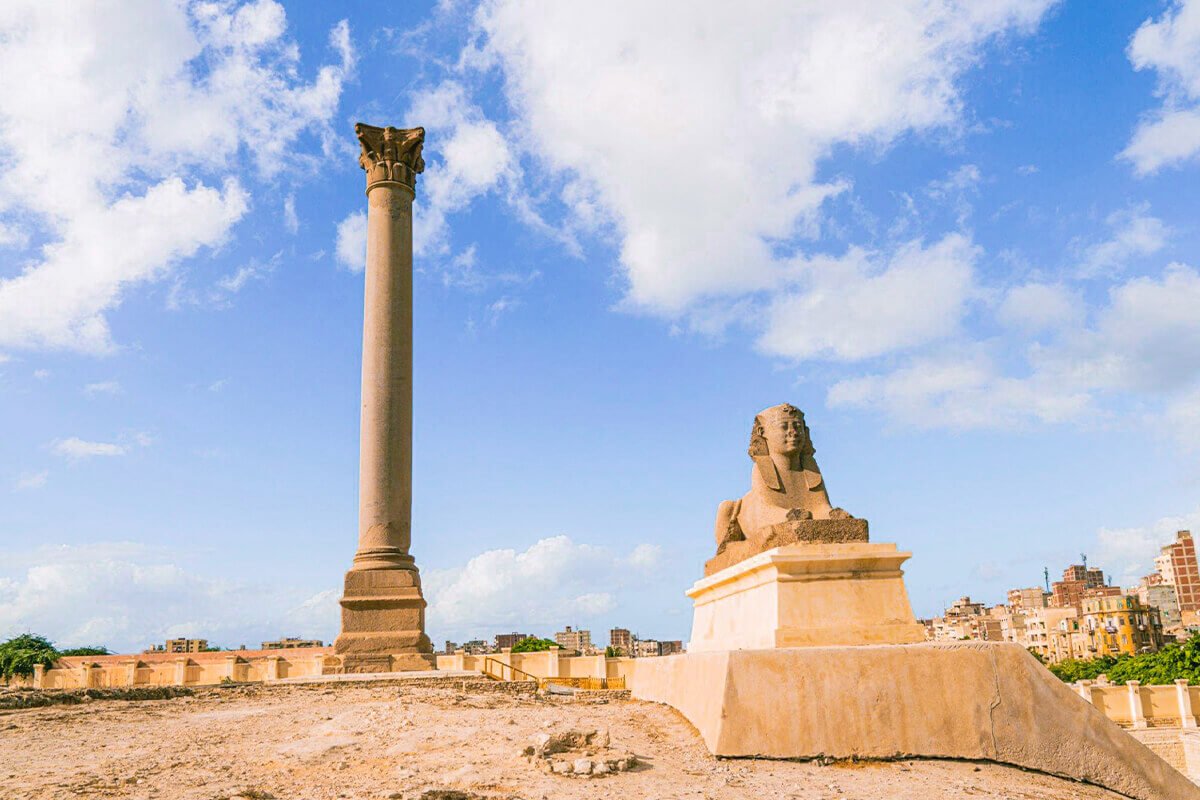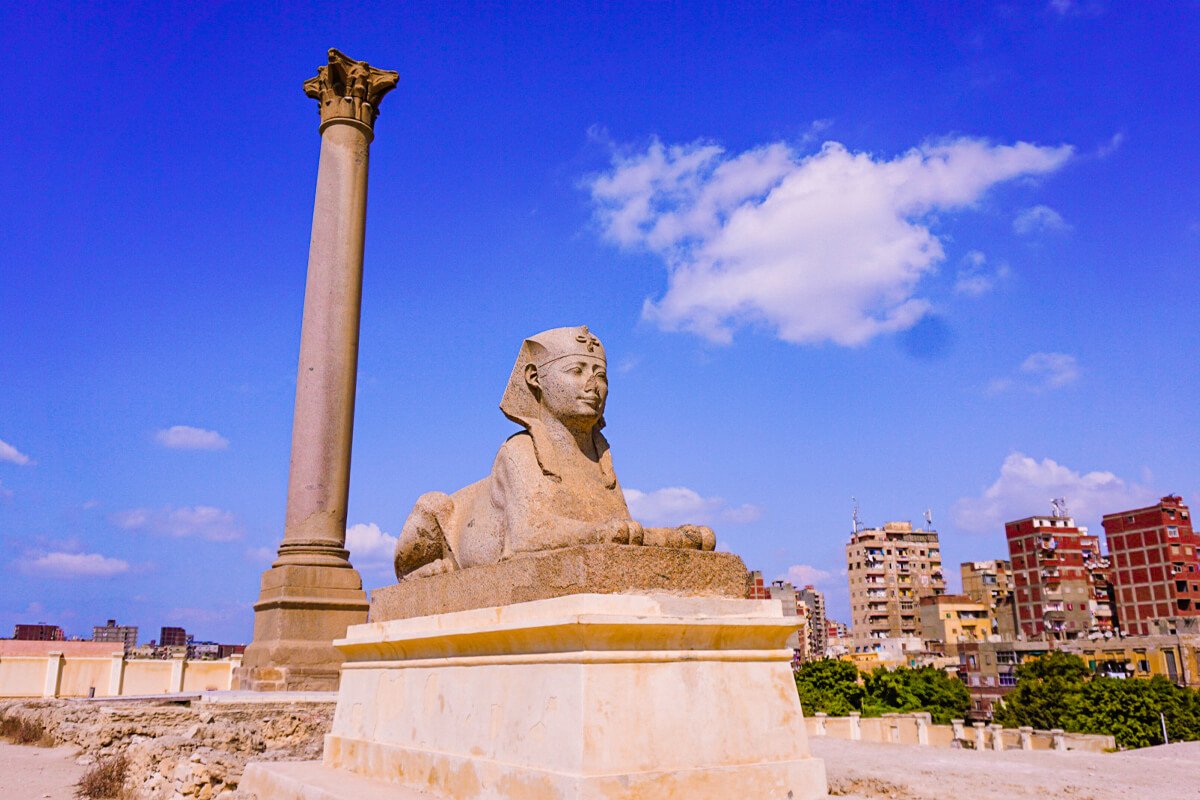The Pompey Pillar: the Ancient Obelisk of Alexandria
In the heart of the enchanting city of Alexandria, a colossal monolith stands as an enduring testament to the grandeur of the past. Pompey Pillar, as it is fondly known, is a historical marvel that beckons travelers and history enthusiasts alike. In this journey through time, we shall unravel the mysteries and grandeur of this iconic landmark, exploring the legends, history, architecture, enigmatic inscriptions, restoration efforts, and tips for an unforgettable visit.
Experience the magic of Egypt with our luxurious Nile Cruises!
Pompey Pillar’s Connection to the Legendary Roman General
At first glance, one might wonder why a pillar in Egypt is named after the renowned Roman general Pompey. The association, however, goes beyond mere terminology. This imposing monolith, a monolithic column of red granite, was not constructed to honor Pompey but to commemorate an earlier, significant Roman victory. It was erected in 297 AD to celebrate the triumphant return of the Roman Emperor Diocletian from the campaign against the rebellious governor Aper.
- Unraveling the Myths and Stories Surrounding the Pillar
Like many historical landmarks, Pompey Pillar is shrouded in a tapestry of myths and stories. It is believed by some to be the resting place of the remains of Pompey, a notion perpetuated by the pillar’s name. The monument’s inscriptions, however, show that it is a tribute to Diocletian’s victory, refuting this unproven theory.

Hike the Egyptian Desert: Secure Your Egypt Desert Safari Tours!
How It Has Inspired Generations
Throughout the ages, the Pompey Pillar has served as a symbol of resilience and victory. Its towering presence has inspired generations, both locals and visitors, to reflect on the enduring power of history and the human spirit. As we delve deeper into its history, the pillar’s significance becomes increasingly apparent, transcending time and borders.
- Historical Context of Pompey Pillar in Ancient Alexandria
To truly appreciate Pompey Pillar, one must delve into the historical context of ancient Alexandria. This bustling city, which Alexander the Great founded, was once a thriving center of culture, trade, and learning. It was in this city that they came into being, a product of the grand ambitions and architectural prowess of the time.
Luxury Nile Cruises – Book Your Relaxation!
The Purpose and Construction of the Pillar
was not raised for mere aesthetic appeal. It was a symbol of victory and the might of the Roman Empire. Constructed from a single piece of red Aswan granite, the pillar stands at an impressive 25 meters (82 feet) in height. The logistical marvel of its construction, especially in ancient times, remains a testament to the engineering skills of the era.
- The Significance of the Inscription
Etched into the very surface of the Pompey Pillar are inscriptions that serve as historical markers. These inscriptions not only honor Diocletian but also provide us with a window into the past. They shed light on the events, people, and ethos of the time, offering invaluable historical insights.
The Marvelous Architecture
Pompey Pillar, with its sheer scale and elegance, is a sight to behold. Its architectural features are a marvel of ancient craftsmanship. The pillar tapers towards the top, showcasing the attention to detail and precision of its creators. The grooves and intricate carvings adorn the pillar’s surface, inviting admiration and intrigue.
- The Unique Design Elements that Set It Apart
What distinguishes Pompey Pillar from other ancient columns is its unique, monolithic construction. While many pillars are assembled from multiple pieces, this towering monolith is a single, unbroken piece of red granite. This exceptional architectural choice has contributed to its longevity and mystique.
- Insights into the Craftsmanship of the Ancient Builders
The construction of the Pompey Pillar is a testament to the architectural prowess of the ancient world. The ability to quarry, transport, and erect such a massive monolith showcases the ingenuity and engineering skills of the artisans of that era. It is a living testament to the dedication and craftsmanship of those who built it.
Experience Egypt in a day. Your journey starts here. Egypt Day Tours.
Deciphering the Inscriptions
The inscriptions on the Pompey Pillar, though weathered by the sands of time, have revealed vital historical information. They tell the story of Diocletian’s victorious return, providing a glimpse into the politics and military campaigns of the Roman Empire. However, interpreting these inscriptions is a task that continues to captivate historians and linguists alike.
- The Languages Used and Their Translations
The inscriptions on Pompey Pillar are multilingual, reflecting the linguistic diversity of the Roman Empire. Latin and Greek, two dominant languages of the time, feature prominently. Translating these inscriptions offers a rich tapestry of historical narratives, enabling us to piece together the past.
- The Historical Insights Provided by the Inscriptions
These inscriptions, like the hieroglyphs of ancient Egypt, guard past secrets. They speak of triumph, leadership, and the enduring legacy of emperors. The historical insights offered by these inscriptions are invaluable in understanding the Roman Empire’s reach and influence.
The Efforts to Protect and Preserve Pillar
The passage of centuries has taken a toll on Pompey Pillar. Its red granite surface has weathered, and time has left its mark. Fortunately, there have been dedicated efforts to protect and preserve this ancient marvel. Conservationists and archaeologists have worked tirelessly to safeguard this pillar for future generations.
- A Look at Its Condition Over the Centuries
Pompey Pillar has endured much since its construction in the 3rd century AD. It has witnessed the rise and fall of empires and the ebb and flow of history. Examining its condition over the centuries offers a glimpse into the trials and tribulations it has weathered.
- The Challenges and Successes in Maintaining This Historical Marvel
Preserving a monument of such historical significance is no small task. The challenges are substantial, ranging from environmental factors to the ravages of time. Yet, there have been notable successes in maintaining the Pompey Pillar, ensuring it remains a beacon of history and culture.
Curious about Egypt Shore Excursions? Let’s answer your questions.
Visiting Pompey Pillar Today
For those who wish to embark on a journey to Pompey Pillar, practical information is essential. It’s located in the Kom El-Dikka area of Alexandria, easily accessible for tourists. Opening hours, admission fees, and restrictions should be considered to plan a successful visit.
Tips for a Memorable Visit
To truly savor the experience of Pompey Pillar, there are a few tips to keep in mind. A visit during the early morning or late afternoon is recommended to avoid the scorching midday sun. Don’t forget to bring comfortable walking shoes and water, as exploring the site may require a bit of a stroll.
Nearby Attractions to Explore in Alexandria
Alexandria, steeped in history and culture, offers many attractions to explore. After visiting Pompey Pillar, consider exploring the Bibliotheca Alexandrina, the Catacombs of Kom El Shoqafa, or enjoying the picturesque Corniche along the Mediterranean coast. The city has much to offer for those keen to dive deeper into its rich heritage.

FAQs about Pompey Pillar
What is the height of the Pompey Pillar?
The pillar stands at an impressive height of 25 meters.
Who built Pompey Pillar?
It was constructed during the reign of the Roman Emperor Diocletian, around 291 AD.
Is Pompey Pillar connected to Pompey the Great?
No, the pillar’s name results from historical misattribution; it is not connected to Pompey the Great.
Can visitors climb Pompey Pillar?
No, climbing the pillar is not allowed to preserve its historical integrity.
What is the material of Pompey Pillar?
It is made from a single piece of red granite, showcasing the impressive craftsmanship of the past.
Conclusion
In the shadow of Pompey Pillar, we find not only a colossal column of granite but a living testament to human ingenuity, history, and the resilience of ancient structures. It stands as a symbol of triumph and the enduring legacy of the Roman Empire. As you reflect on the allure of Pompey Pillar, you’ll come to appreciate the cultural and historical significance that this marvel embodies. We invite you to stand in its presence, to experience the stories etched into its surface, and to immerse yourself in the grandeur of a bygone era. Beckons and the echoes of history await your exploration.
Discover Egypt’s ancient wonders! Book your Egypt Packages now!



